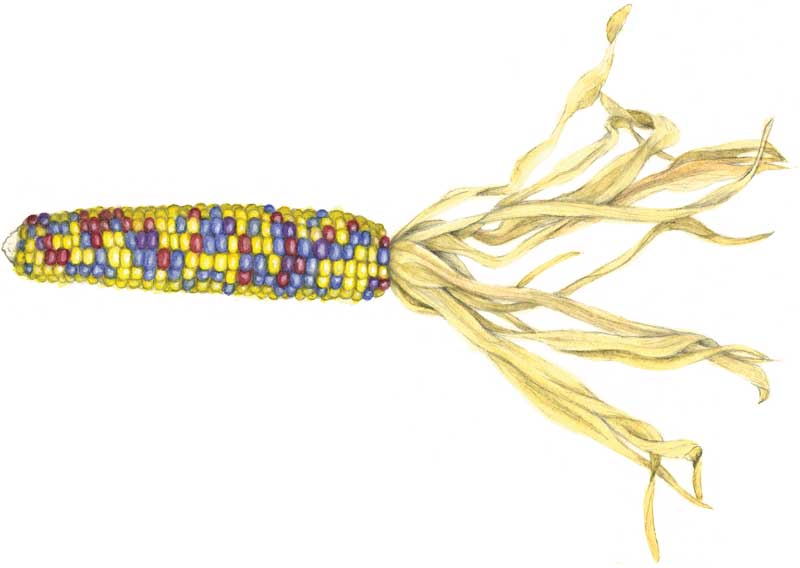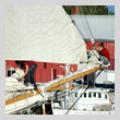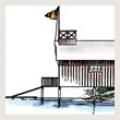Welcome Downeast
The Town, the Bays, the Mountains
“Come, ye thankful people, come;
Raise the song of harvest home.
All is safely gathered in,
Ere the winter storms begin.”
—Henry Alford, 1844
Dear Friends:
Here we are at the first week in November and still waiting for a hard freeze. Apples thud to the ground, acorns rattle and roll off the roof, burdock brandishes its burrs, and milkweed seeds sail on the withering winds. Everything is going to seed. The soft green symmetry of summer stem and stalk has been reduced to dry and rattling brown as the frosts drive life down into the ground. The fragrant and flaming flowers that recently beckoned bees and butterflies have shed their tender petals and turned their inner parts outward into seed parcels ready to begin their lives again in spring.
Some seeds are covered in sweet-fleshed fruit or cased in hard shiny shells to be scattered by squirrels and birds. Some waft on the wind on silken sails. Some are armored with spines that cling to the coats of ambling animals. All are elegantly designed to carry on the lives of their kind. Most of these seeds will never live again, but some will find themselves on fertile ground, where they will sprout and grow to bring to bloom again the whole hidden history of their kind, all their labor, learning, and legacy concentrated into the germination bank of the future.
Natural events, November
Since the dawn of agriculture possibly 20,000 years ago, saving seeds from crops with the best qualities has been a traditional practice. In this way, humans have collectively developed the major food crops which feed the world’s billions today. At the time of harvest, seeds from the best plants are set aside and preserved, usually in air-tight jars or pots in a cool, dark, dry place. Seeds are exchanged between farmers so they may grow crops more adapted to their conditions. The result is a gradual improvement in crop plants by the process of human-aided evolution. Corn or “maize,” which now is the most widely grown grain in the Western Hemisphere, apparently started out in southern Mexico about 9,000 years ago as a wild grass called “teosinte.” Naturally, this evolution involved saving and exchanging seeds from one year to the next and it still does. In today’s environmental crisis, seed banks like Navdanya in India and Millennium seed bank in England are preserving seeds of many crops and endangered species to keep them safe for future use.
Field and forest report
There are three working farms in easy walking distance from our Eggemoggin Field Station—Carding Brook, Stoneset, and Poland Family farms. This offers many benefits, including fresh vegetables and fruits in season; the sounds of roosters crowing, chickens clucking, and cattle lowing; and the sights of great draft horses pulling, goats climbing stone walls, and little black pigs foraging for acorns under the oak trees, with a home-made sign beside the road saying on one side “Beware: Swine Strolling” and on the other side: “Pigs Patrolling” or something like that.
It is traditional in autumn to let the pigs loose in the woods to feed on “mast,” that is, the fallen nuts of oak, beech, hazel, and others. Those years when the wild nut crop is heavy are called “mast years” and they are a boon to squirrels, jays, black bears, and foraging pigs. There is speculation that oak trees somehow decide together to all crop heavily in a given year, and your commentator does not want to dispel that beautiful notion of a council of mighty oaks. Nevertheless, a lifetime of tree-watching and caretaking suggests that weather conditions during pollination are the main determining factor for the abundance of the crop, as it is with fruit trees and many other plants.
Historical reflection
From that fall feast at Plymouth bringing together pious Pilgrims, professional soldiers, members of Native American tribes, children and teenagers, and various and sundry others, right down to today, with family and friends of differing opinions gathered around the table, Thanksgiving dinner has been an emblem of overcoming differences for the one purpose of giving thanks together. May this Thanksgiving bring the big, brawling, bragging, fumbling, faithful family that is America peacefully together in this high purpose: gratitude for our country.
Rank opinion
Since the beginning of time, giving thanks has been a regular observance among us humans. What we call the “First Thanksgiving” at Plymouth was not the first, but just one more in a multitude. That is because Thanksgiving is also a socially, economically, and ecologically beneficial practice. Gratitude mitigates greed. We do not destroy what we appreciate. We do not waste or ruin what we are thankful for. We do not hoard what is not ours. All ancient people knew this and so universally expressed thanksgiving in their spiritual practices. This is not simply some lofty sentiment. Gratitude is hard-wired into the human soul. That is how humans lived sustainably on the earth for millions of years. And that is why a simple meal eaten gratefully is far more satisfying than the richest feast eaten mindlessly.
 Illustration by Candice Hutchison
Illustration by Candice Hutchison
Natural events, December
Now that Thanksgiving is accomplished, we are preparing for year-end holidays, and for winter. We button up the house, put some extra covers on the bed, and haul out our cold-weather gear for when the winds begin to bite. We do this because we know from experience what is ahead.
Other creatures are snugging up their houses and putting on their winter coats, too. The deer have added a heavy gray pelt over their lighter red coats. Black bears are adding a layer of insulating fat and an extra layer to their fur coats before they go down for their long winter’s nap. Both the weasel and the varying hare shed their earth-brown summer coats and put on white for winter. Every creature in its own way prepares for the season ahead. The question of whether they all really know what is coming, or whether this is inborn instinct, or whether it really matters, we will leave for another day.
Saltwater report
The haunting call of the loon across the water is so well-known that it has become the proverbial “call of the wild” for the North Woods. Equally familiar is the summer garb of this huge diver: black and white speckled back, striped white collar on a deep black background. But around September our loons begin to lose their iconic markings and soon are dressed in a motley gray above and light gray to white on breast and belly. This is the winter plumage of our Great Northern Diver, not nearly so charismatic, but much more practical when courting season is over. If you are wondering where “Kwimu” has gone, she might still be out there, just looking a little different.
Rank opinion
When I was a lad, I belonged to the Boy Scouts. As a small town outdoor kid trapped in suburbia, the Scouts saved my life, teaching woodcraft, first aid, how to handle firearms, and what are called today “survival skills” for emergencies. The Scouts’ first rule was “Be Prepared.” Sixty years have passed since then, and now the whole world seems to be preparing for emergencies in one way or another; whether it’s rising sea levels, wildfires, a global crash, or an asteroid strike, to name some of our current obsessions. So, it might be worth noting here one more thing animals do to prepare for winter. They gather together. Deer may run in two and threes in summer, but they over-winter in herds. Eiders gather in rafts of hundreds chatting and calling out to each other in the cold. Crows, ravens, and blue jays forage in family groups. Survival for many species, including our ancestors, has always meant not holing up in your bunker or burrow alone, but joining with others to face the gloom together. And isn’t that what this holiday season is all about?
Field and forest report
Though the solstice is still weeks away, we landed on Planet Winter with snowfall and blustery winds announcing touch-down on that cold orb. Before that first snow of the season was washed away it was etched far and wide with fleeting accounts of animal activity written in code. Here a crow landed to forage under the snow. There the deer walked through the orchard and parted the white cover with their hooves looking for apples. So evocative are these writings that we can almost see the creatures who inscribed them, and think their thoughts, too.
One of the great benefits of living way out on the narrow two-lane roads far from the Interstate, far from the cities, and face to face with the forces of the Creation, is that you can walk directly out into the presence of the Great Benevolent Spirit which created the entire world—yourself included—out of all the same stuff.
Seedpods to carry around with you
From the Haudenosaunee, Six Nations of the Iroquois: “We turn our thoughts to our Creator, and send greetings and thanks for all the gifts of Creation. Everything we need to live a good life is here on this Mother Earth. For all the love that is still around us, we gather our minds together as one and send our choicest words of greetings and thanks to our Creator.”
From the Book of Genesis: “While the earth remains, seedtime and harvest, cold and heat, summer and winter, day and night shall not cease.”
That’s the Almanack for this time. But don’t take it from us—we’re no experts. Go out and see for yourself.
Yr. mst. humble & obd’nt servant,
Rob McCall N
Rob McCall splits his time between Moose Island and Brooklin, Maine. This almanack is excerpted from his radio show on WERU FM, which can be streamed on weru.org.
Related Articles
Share this article:
2023 Maine Boat & Home Show

Join Us for the Maine Boat & Home Show!
Art, Artisans, Food, Fun & Boats, Boats, Boats
August 11 - 13, 2023 | On the waterfront, Rockland, Maine
Click here to pre-order your tickets.
Show is produced by Maine Boats, Homes & Harbors magazine.















